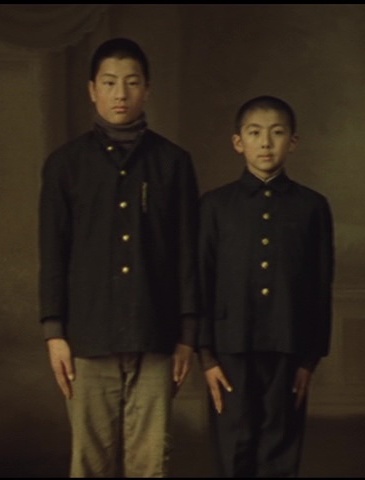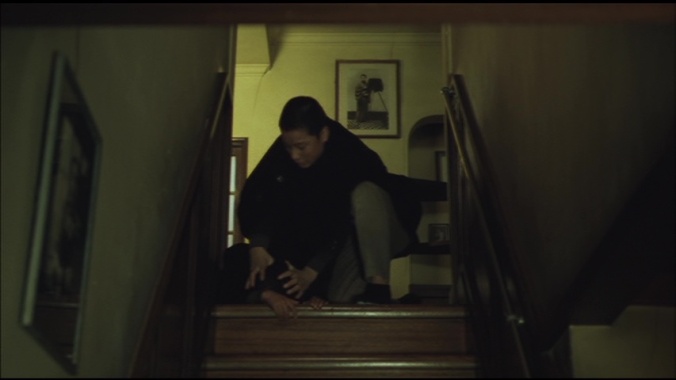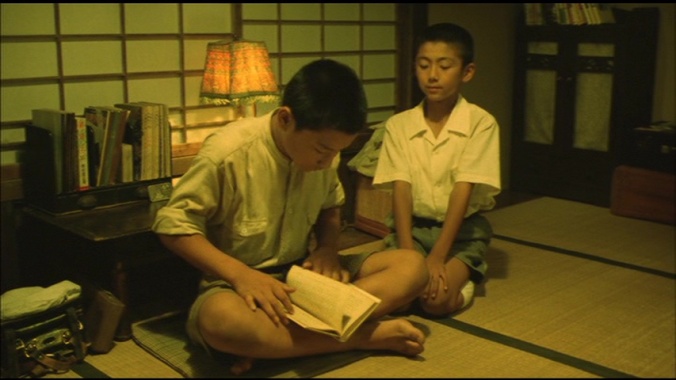 In the fall of 1944, young Shinji is sent to stay with his uncle’s family in the country, while his father, a government bureaucrat, prepares for the Tokyo bombings he knows will come soon. In his new home, Shinji meets Takeshi, the “class captain” and general top dog in the school. Over the next year, the two develop an odd relationship as we follow the two through the last year of the war.
In the fall of 1944, young Shinji is sent to stay with his uncle’s family in the country, while his father, a government bureaucrat, prepares for the Tokyo bombings he knows will come soon. In his new home, Shinji meets Takeshi, the “class captain” and general top dog in the school. Over the next year, the two develop an odd relationship as we follow the two through the last year of the war.
Shinji is, as we might expect, an outsider in his new home, his Tokyo accent ridiculed, his Tokyo school uniform feared, and his leather shoes as opposed to the local’s sandals envied. Initially, Takeshi befriends him until the girl Minako, the only other refugee in the village, visits Shinji’s house. From that point on, the boys develop a love-hate relationship in which Takeshi alternately bullies and protects the very small Shinji. The slowest boy in the class, and the biggest, is Futoshi, who also becomes Shinji’s friend when he finds out that Shinji can tell him stories from books that Futoshi can’t read. Shinji is a bookish boy, who has read all the boys’ books available, so he knows a lot of stories, from the Count of Monte Cristo to Edgar Allen Poe to Black Mask to detective Akechi. Takeshi beats up Futoshi and brings Shinji back into his clique, to which Shinji also tells his stories, makes him vice-captain, and even goes on a daring bicycle ride to the nearest large town to protect Shinji from the gang there, whom Takeshi had earlier fought.
When they have their picture taken together and hide from the gang, Shinji asks the central question of their relationship: “You are so nice to me, so why do you bully me?” Slamming Shinji’s head to the floor, Takeshi can only answer “Don’t you know?”
Eventually Shinji’s reign is overturned after the return of the former vice-captain Sudo, who has been ill. Sudo it turns out is from the village rich family, and he and Shinji bond over the library Sudo has accumulated. Sudo gradually gathers together all the boys Takeshi has bullied, and as a gang they beat him up. Yielding to peer pressure, the tormented Shinji joins in, after which Takeshi resigns his captaincy and speaks to no one. Yet he races after the train when Shinji’s mother reapppears to take him home and both boys wave farewell until out of sight of each other.
The movie has the polish but lacks the sentimentality of Shinoda’s earlier MacArthur’s Children, which dealt with children of the same age. It is, as the Japanese title indicates, the story of Takeshi, not Shinji, though everything is told through the eyes of Shinji. Their exact age is not clear – fifth grade, we are told. They are still leery of girls and Shinji is seen rushing to erase chalkings that say “Minako loves Shinji” before any of the other boys can see them. They are also at that age when growth spurts are random, so part of Takeshi’s authority comes from the fact that he is a head taller than most of the boys and is very muscular. But Takeshi is no ordinary class bully, because he is also the smartest boy in the class, hence his appointment by the teacher to be class captain. He is also extremely poor and desperate for stories to read. As Sudo tells Shinji, they will go on to “middle school,” but Takeshi will not because his family can’t afford it. When not at school, we see Takeshi always at work, planting, oaring his father’s fishing boat, and even carrying the family baby with him when he comes to visit Shinji.
As Sudo tells Shinji, they will go on to “middle school,” but Takeshi will not because his family can’t afford it. When not at school, we see Takeshi always at work, planting, oaring his father’s fishing boat, and even carrying the family baby with him when he comes to visit Shinji.
The war is still present, even in the far-away village. The students are shown a movie which seems to be about three years out of date, showing the Americans being pushed out of the Philippines and Hitler reviewing troops and meeting with the Italians. The boys practice bayonet thrusts in the gym with caricatures of Churchill and FDR as their target. They see the glow of fires after the bombing of the nearest large town. The children make ropes for the military to use. The boyfriend of Futoshi’s sister is drafted, sent off with cheering crowds at the station, and her father beats her because she dares to cry about it. After Takeshi appears with a limp, the teacher lectures the class that the boys must not fight because their bodies belong to the nation and therefore must not be injured.
Perhaps intentionally ironic, Takeshi is in fact being wasted by the nation. Frustrated and confused, he lives inside a culture that offers no opportunities for a boy like him. But that is never stated, by him or by his teachers. The story told is of a strange, complex friendship within the life of young boys.
None of the boys are professional child actors, but Yuji Horioka as Takeshi has both the looks, charisma, and intensity that indicates he might have built a career when older. Shinoda has elicited remarkably realistic performances from this amateur cast, more complex than those in MacArthur’s Children.
With the photography of Tatsuo Suzuki, who had been producing physically gorgeous films since 1965, including Shinoda’s Under the Blossoming Cherry Trees, there is no shortage of beautiful scenes of the countryside. Takeshi was extremely popular, apparently Shinoda’s most commercially successful film, and swept most of the movie awards of its year, though it has been critically forgotten since. Based on a book by Hyozo Kashiwabara,* it nevertheless has the feel of an autobiographical movie. Shinoda himself would have been about the same age as the characters in 1944-45, which certainly would have given him empathy with the boys, but from his known personal history was not a Tokyo refugee and would more likely have been like the character Sudo than either Shinji or Takeshi. Nevertheless, along with MacArthur’s Children and his later Moonlight Serenade. it forms a loose trilogy about boys growing up in the late war and early Occupation.
* Because it was produced by Fujiko Fujio A, one of the most famous manga authors of the day, it is sometimes mistakenly credited as being based on a manga.
Hello,is there any way l can watch these magnificent films that you have written about?
l scour Youtube for any of Ozu and Mikio Naruse films,what a golden period of cinema.
Thank you
Michael
LikeLike
I scour the web for suppliers, many of which turn out to be in Europe. It’s mostly pot-luck though, and few are free as on YouTube.
LikeLike
Pingback: Hope and Pain / Downtown Heroes / Dauntaun hirozu (1988) | Japanonfilm
Pingback: Roadside Stone / Pebble by the Wayside / Robo no ishi (1938) | Japanonfilm
Pingback: Village of Dreams / E no naka no boku no mura (1996) | Japanonfilm
Pingback: All My Children / Minna waga ko (1963) | Japanonfilm
Pingback: Roadside Stone / Robo no ishi (1964) | Japanonfilm